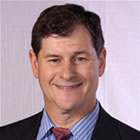
An operatic tenor in action…
One of the intriguing things about angioplasty when it was first introduced, was that patients undergoing this profound, life-changing heart treatment remain awake throughout the procedure.
In the 1980’s my partner Burt Cohen, a filmmaker, began producing live televised training courses to teach cardiologists this new non-surgical way of treating heart disease. Procedures were broadcast from a hospital catheterization lab, and projected on giant screens set up in a conference center auditorium. The patients on the hospital cath lab table would look into the cameras and wave to the audience of physicians gathered in the auditorium, all of whom were waiting to see, in real time, how the procedure turned out.
One of the most memorable moments from that period was at a live teleconference broadcast to the US from Dr. Antonio Colombo’s cath lab in Italy. The screen filled with the face of a tenor from the Milan Opera who was lying on a cath table as he began singing O Sole Mio, reaching a crescendo as a buzzing catheter-based device in his heart began shaving plaque from his arteries.
The physician audience burst into applause, it seemed remarkable that a patient whose heart was being ‘operated on’ could be that alert, aware and energized.
So now when I think about the idea of the activated patient, that opera singer comes to mind.
Of course no one is 100% activated during a catheterization – you are sedated, and probably afraid, possibly even feeling fundamentally powerless.
But the evolution of less invasive, less traumatic techniques is part of a general trend toward improving the experience of medical care from the patient’s perspective. And a focus of 21st century healthcare will be on patients actively participating in their own individualized treatment, especially heart patients, who only 40 years ago were told to rest, avoid activity, and expect to deteriorate, and today are encouraged to exercise, self-manage and assume they can live a long, full, vigorous life.
We spent a long time choosing a name for this blog: the empowered patient, the informed patient, the educated patient, the engaged patient, we tossed around many of the trending terms that signal a more patient-centered attitude toward heart health.
But activated stuck because, like that tenor’s will to sing, it seems to capture a quality that belongs to the patient and comes from within – not something health professionals do to patients (educate, inform), or permit (empower, engage), but something patients summon up and create for themselves.
An activated patient is endeavoring to do whatever she or he has to do, to get what they know in their gut they need, in order to feel well and in control, hopeful and moving forward.
In the practical sense, an activated patient is an individual who has embraced the possibility of consciously acting in their own interest by equipping themselves with the information and skills they need to be an expert in their own care.
But while an activated patient is, by definition, self-directed, an activated patient can only prevail in a system that responds.
Activated patients not only need the motivation to be well, but a ton of information, skills, confidence, support, options and perseverance. That’s where educational projects like this one come in – hoping to help provide the coaching, the techniques, the libretto, the throat lozenges, the accompaniment, and the encouragement the singer needs to sing.
I’m not a fan of resolutions, because I’m not a fan of setting myself up for failure. But I am a fan of new beginnings, fresh opportunities and future plans. It would feel pretty good to me to be activated in my own life in the coming year. Most of us would benefit from taking an activated stance toward our bodies, our ailments, our daily routines, our work and our personal lives.
Whether it’s heart disease, or aging, or family issues, or career challenges, or finances, or any of a million obstacles, there are always pretty powerful forces at work promoting discouragement, disempowerment, inaction and anxiety. Activating doesn’t mean denying these realities, it means living in and with our lives as they are, assessing our options, and acting with commitment to our own best interest.
Activating entails trusting ourselves and seeking the help we need. I’m not the type of person who could sing opera with a catheter in my heart, but I sure like the idea of doing what defines you, no matter what.
Taking steps to get better, to feel stronger, to give ourselves breathing space, to engage deeply with life, and to enjoy as much as we can, could be posited as resolutions, or shoulds, or burdens we need to discipline ourselves to take on.
Or, we could think of becoming more activated as remaining awake, as allowing ourselves to be entitled to possibility, and to hope, to want more for ourselves, because it’s what we deserve.
Becoming activated is the opposite of easy or effortless, but it feels strong, it feels purposeful, it feels good and, it turns out, it’s better for our health and our hearts.
posted by Deborah Shaw, Angioplasty.Org Patient Education Editor




 RSS Feed
RSS Feed

 Taking Charge of your Health
Taking Charge of your Health
 How Long will a Stent Last?
How Long will a Stent Last?